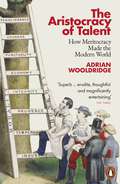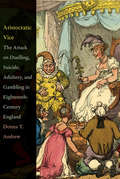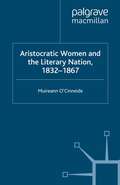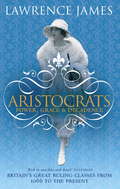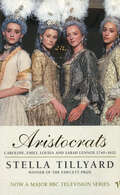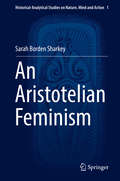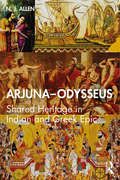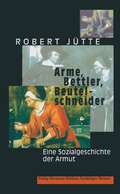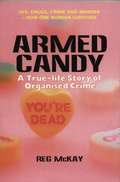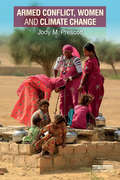- Table View
- List View
The Aristocracy of Talent: How Meritocracy Made the Modern World
by Adrian Wooldridge'This unique and fascinating history explains why the blame now being piled upon meritocracy for many social ills is misplaced-and that assigning responsibilities to the people best able to discharge them really is better than the time-honoured customs of corruption, patronage, nepotism and hereditary castes. Wooldridge upends many common assumptions and provides an indispensable back story to this fraught and pressing issue.' Steven Pinker'The Aristocracy of Talent provides an important and needed corrective to contemporary critiques of meritocracy. It puts meritocracy in an illuminating historical and cross-cultural perspective that shows how crucial the judgment of people by their talents rather than their bloodlines or connections has been to creating the modern world. Highly recommended' Francis FukuyamaMeritocracy: the idea that people should be advanced according to their talents rather than their status at birth. For much of history this was a revolutionary thought, but by the end of the twentieth century it had become the world's ruling ideology. How did this happen, and why is meritocracy now under attack from both right and left? Adrian Wooldridge traces the history of meritocracy forged by the politicians and officials who introduced the revolutionary principle of open competition, the psychologists who devised methods for measuring natural mental abilities and the educationalists who built ladders of educational opportunity. He looks outside western cultures and shows what transformative effects it has had everywhere it has been adopted, especially once women were brought into the meritocractic system.Wooldridge also shows how meritocracy has now become corrupted and argues that the recent stalling of social mobility is the result of failure to complete the meritocratic revolution. Rather than abandoning meritocracy, he says, we should call for its renewal.
Aristocratic Vice: The Attack on Duelling, Suicide, Adultery, and Gambling in Eighteenth-Century England
by Donna T. AndrewAristocratic Vice examines the outrage against—and attempts to end—the four vices associated with the aristocracy in eighteenth-century England: duelling, suicide, adultery, and gambling. Each of the four, it was commonly believed, owed its origin to pride. Many felt the law did not go far enough to punish those perpetrators who were members of the elite. In this exciting new book, Andrew explores each vice’s treatment by the press at the time and shows how a century of public attacks on aristocratic vices promoted a sense of “class superiority” among the soon-to-emerge British middle class.“Donna Andrew continues to illuminate the mental landscapes of eighteenth-century Britain. . . . No historian of the period has made greater or more effective use of the newspaper press as a source for cultural history than she. This book is evidently the product of a great deal of work and is likely to stimulate further work.”—Joanna Innes, University of Oxford
Aristocratic Women and the Literary Nation, 1832-1867 (Palgrave Studies in Nineteenth-Century Writing and Culture)
by M. O'CinneideAristocratic women flourished in the Victorian literary world, their combination of class privilege and gendered exclusion generating distinctively socialized modes of participation in cultural and political activity. Their writing offers an important trope through which to consider the nature of political, private and public spheres.
Aristocrats: Power, grace and decadence - Britain's great ruling classes from 1066 to the present
by Lawrence JamesFor nine hundred years the British aristocracy has considered itself ideally qualified to rule others, make laws and guide the fortunes of the nation. Tracing the history of this remarkable supremacy, ARISTOCRATS is a story of wars, intrigue, chicanery and extremes of both selflessness and greed. James also illuminates how the aristocracy's infatuation with classical art has forged our heritage, how its love of sport has shaped our pastimes and values - and how its scandals have entertained the public. Impeccably researched, balanced and brilliantly entertaining, ARISTOCRATS is an enthralling history of power, influence and an extraordinary knack for survival.
Aristocrats: Caroline, Emily, Louisa and Sarah Lennox 1740 - 1832
by Stella TillyardA fascinating insight into 18th century aristocratic life through the lives of the four Lennox sisters, the great grandchildren of Charles II, whose extraordinary lives spanned the period 1740-1832. Passionate, witty and moving, the voices of the Lennox sisters reach us with immediacy and power, drawing the reader into their remarkable lives, and making this one of the most enthralling historical naratives to appear for many years.
An Aristotelian Feminism (Historical-Analytical Studies on Nature, Mind and Action #1)
by Sarah Borden SharkeyThis book articulates the theoretical outlines of a feminism developed from Aristotle’s metaphysics, making a new contribution to feminist theory. Readers will discover why Aristotle was not a feminist and how he might have become one, through an investigation of Aristotle and Aristotelian tradition. The author shows how Aristotle’s metaphysics can be used to articulate a particularly subtle and theoretically powerful understanding of gender that may offer a highly useful tool for distinctively feminist arguments.This work builds on Martha Nussbaum’s ‘capabilities approach’ in a more explicitly and thoroughly hylomorphist way. The author shows how Aristotle’s hylomorphic model, developed to run between the extremes of Platonic dualism and Democritean atomism, can similarly be used today to articulate a view of gender that takes bodily differences seriously without reducing gender to biological determinations.Although written for theorists, this scholarly yet accessible book can be used to address more practical issues and the final chapter explores women in universities as one example. This book will appeal to both feminists with limited familiarity with Aristotle’s philosophy, and scholars of Aristotle with limited familiarity with feminism.
Aristotle and the Ethics of Difference, Friendship, and Equality: The Plurality of Rule
by Zoli FilotasConnecting several strands of Aristotle's thought, Zoli Filotas sheds light on one of the axioms of Aristotle's ethics and political philosophy – that every community has a ruler – and demonstrates its relevance to his ideas on personal relationships. Aristotle and the Ethics of Difference, Friendship, and Equality reveals a pluralistic theory of rule in Aristotle's thought, tracing it through his corpus and situating it in a discussion among such figures as Gorgias, Xenophon, and Plato. Considering the similarities and differences among various forms of rule, Filotas shows that for Aristotle even virtuous friends must exercise a version of rule akin to that of slaveholders. He also explores why Aristotle distinguishes the hierarchical rule over women from both the mastery of slaves and the political rule exercised by free and equal citizens. In doing so, he argues that natural and social differences among human beings play a complex, and troubling, role in Aristotle's reasoning. Illuminating and thought-provoking, this book reveals Aristotle's ambivalence about political relations and the equal treatment they involve and offers an engaging inquiry into how he understood the common structures of human relationships.
Aristotle and the Ethics of Difference, Friendship, and Equality: The Plurality of Rule
by Zoli FilotasConnecting several strands of Aristotle's thought, Zoli Filotas sheds light on one of the axioms of Aristotle's ethics and political philosophy – that every community has a ruler – and demonstrates its relevance to his ideas on personal relationships. Aristotle and the Ethics of Difference, Friendship, and Equality reveals a pluralistic theory of rule in Aristotle's thought, tracing it through his corpus and situating it in a discussion among such figures as Gorgias, Xenophon, and Plato. Considering the similarities and differences among various forms of rule, Filotas shows that for Aristotle even virtuous friends must exercise a version of rule akin to that of slaveholders. He also explores why Aristotle distinguishes the hierarchical rule over women from both the mastery of slaves and the political rule exercised by free and equal citizens. In doing so, he argues that natural and social differences among human beings play a complex, and troubling, role in Aristotle's reasoning. Illuminating and thought-provoking, this book reveals Aristotle's ambivalence about political relations and the equal treatment they involve and offers an engaging inquiry into how he understood the common structures of human relationships.
Arjuna–Odysseus: Shared Heritage in Indian and Greek Epic
by N. J. AllenBringing together the study of the Greek classics and Indology, Arjuna–Odysseus provides a comparative analysis of the shared heritage of the Mahābhārata and early Greek traditions presented in the texts of Homer and Hesiod. Building on the ethnographic theories of Durkheim, Mauss, and Dumont, the volume explores the convergences and rapprochements between the Mahābhārata and the Greek texts. In exploring the networks of similarities between the two epic traditions, it also reformulates the theory of Georges Dumézil regarding Indo-European cultural comparativism. It includes a detailed comparison between journeys undertaken by the two epic heroes – Odysseus and Arjuna – and more generally, it ranges across the philosophical ideas of these cultures, and the epic traditions, metaphors, and archetypes that define the cultural ideology of ancient Greece and India. This book will be useful to scholars and researchers of Indo-European comparativism, social and cultural anthropology, classical literature, Indology, cultural and post-colonial studies, philosophy and religion, as well as to those who love the Indian and Greek epics.
Arjuna–Odysseus: Shared Heritage in Indian and Greek Epic
by N. J. AllenBringing together the study of the Greek classics and Indology, Arjuna–Odysseus provides a comparative analysis of the shared heritage of the Mahābhārata and early Greek traditions presented in the texts of Homer and Hesiod. Building on the ethnographic theories of Durkheim, Mauss, and Dumont, the volume explores the convergences and rapprochements between the Mahābhārata and the Greek texts. In exploring the networks of similarities between the two epic traditions, it also reformulates the theory of Georges Dumézil regarding Indo-European cultural comparativism. It includes a detailed comparison between journeys undertaken by the two epic heroes – Odysseus and Arjuna – and more generally, it ranges across the philosophical ideas of these cultures, and the epic traditions, metaphors, and archetypes that define the cultural ideology of ancient Greece and India. This book will be useful to scholars and researchers of Indo-European comparativism, social and cultural anthropology, classical literature, Indology, cultural and post-colonial studies, philosophy and religion, as well as to those who love the Indian and Greek epics.
Ark of Civilization: Refugee Scholars and Oxford University, 1930-1945
by Jaś Elsner Sally Crawford Katharina UlmschneiderIn the opening decades of the twentieth century, Germany was at the cutting edge of arts and humanities scholarship across Europe. However, when many of its key thinkers - leaders in their fields in classics, philosophy, archaeology, art history, and oriental studies - were forced to flee to England following the rise of the Nazi regime, Germany's loss became Oxford's gain. From the mid-1930s onwards, Oxford could accurately be described as an 'ark of knowledge' of western civilization: a place where ideas about art, culture, and history could be rescued, developed, and disseminated freely. The city's history as a place of refuge for scientists who were victims of Nazi oppression is by now familiar, but the story of its role as a sanctuary for cultural heritage, though no less important, has received much less attention. In this volume, the impact of Oxford as a shelter, a meeting point, and a centre of thought in the arts and humanities specifically is addressed, by looking both at those who sought refuge there and stayed, and those whose lives intersected with Oxford at crucial moments before and during the war. Although not every great refugee can be discussed in detail in this volume, this study offers an introduction to the unique conjunction of place, people, and time that shaped Western intellectual history, exploring how the meeting of minds enabled by libraries, publishing houses, and the University allowed Oxford's refugee scholars to have a profound and lasting impact on the development of British culture. Drawing on oral histories, previously unpublished letters, and archives, it illuminates and interweaves both personal and global histories to demonstrate how, for a short period during the war, Oxford brought together some of the greatest minds of the age to become the custodians of a great European civilization.
Ark of Civilization: Refugee Scholars and Oxford University, 1930-1945
In the opening decades of the twentieth century, Germany was at the cutting edge of arts and humanities scholarship across Europe. However, when many of its key thinkers - leaders in their fields in classics, philosophy, archaeology, art history, and oriental studies - were forced to flee to England following the rise of the Nazi regime, Germany's loss became Oxford's gain. From the mid-1930s onwards, Oxford could accurately be described as an 'ark of knowledge' of western civilization: a place where ideas about art, culture, and history could be rescued, developed, and disseminated freely. The city's history as a place of refuge for scientists who were victims of Nazi oppression is by now familiar, but the story of its role as a sanctuary for cultural heritage, though no less important, has received much less attention. In this volume, the impact of Oxford as a shelter, a meeting point, and a centre of thought in the arts and humanities specifically is addressed, by looking both at those who sought refuge there and stayed, and those whose lives intersected with Oxford at crucial moments before and during the war. Although not every great refugee can be discussed in detail in this volume, this study offers an introduction to the unique conjunction of place, people, and time that shaped Western intellectual history, exploring how the meeting of minds enabled by libraries, publishing houses, and the University allowed Oxford's refugee scholars to have a profound and lasting impact on the development of British culture. Drawing on oral histories, previously unpublished letters, and archives, it illuminates and interweaves both personal and global histories to demonstrate how, for a short period during the war, Oxford brought together some of the greatest minds of the age to become the custodians of a great European civilization.
The Ark of Taste: Delicious and Distinctive Foods That Define the United States
by David S Shields Giselle Kennedy LordExplore and enjoy the heritage foods that give the United States its culinary identity, from heirloom tomatoes to Tupelo honey, in this visual volume for curious eaters, gardeners and home cooks. The Ark of Taste is a living catalog of our nation's food heritage preserving treasures passed down for generations—some rare, some endangered, all delicious. Created by Slow Food USA, the Ark shines light on history, identity, and taste through these unique food products, featuring recipes and the stories of how they reach our tables In these pages you'll learn about: Carolina Gold rice Wellfleet oysters Cherokee Purple tomatoes The Moon and Stars watermelon Black Republican cherries Candy Roaster squash, and more These foods reflect our country's diversity. By championing them, we keep them in production and on our plates, while promoting a more equitable alternative to industrial agriculture.The Ark of Taste is a vital resource for all of us who spend the summer searching for that perfectly ripe peach or heirloom tomato—or who are simply looking for the next good thing to eat.
Armageddon in Waco: Critical Perspectives on the Branch Davidian Conflict
by Stuart A. WrightOn February 28, 1993, the United States Bureau of Alcohol, Tobacco, and Firearms (BATF) launched the largest assault in its history against a small religious community in central Texas. One hundred agents armed with automatic and semi automatic weapons invaded the compound, purportedly to execute a single search and arrest warrant. The raid went badly; four agents were killed, and by the end of the day the settlement was surrounded by armored tanks and combat helicopters. After a fifty-one day standoff, the United States Justice Department approved a plan to use CS gas against those barricaded inside. Whether by accident or plan, tanks carrying the CS gas caused the compound to explode in fire, killing all seventy-four men, women, and children inside. Could the tragedy have been prevented? Was it necesary for the BATF agents to do what they did? What could have been done differently? Armageddon in Waco offers the most detailed, wide-ranging analysis of events surrounding Waco. Leading scholars in sociology, history, law, and religion explore all facets of the confrontation in an attempt to understand one of the most confusing government actions in American history. The book begins with the history of the Branch Davidians and the story of its leader, David Koresh. Chapters show how the Davidians came to trouble authorities, why the group was labeled a "cult," and how authorities used unsubstantiated allegations of child abuse to strengthen their case against the sect. The media's role is examined next in essays that considering the effect on coverage of lack of time and resources, the orchestration of public relations by government officials, the restricted access to the site or to countervailing evidence, and the ideologies of the journalists themselves. Several contributors then explore the relation of violence to religion, comparing Waco to Jonestown. Finally, the role played by "experts" and "consultants" in defining such conflicts is explored by two contributors who had active roles as scholarly experts during and after the siege The legal and consitutional implications of the government's actions are also analyzed in balanced, clearly written detail.
Armageddon in Waco: Critical Perspectives on the Branch Davidian Conflict
by Stuart A. WrightOn February 28, 1993, the United States Bureau of Alcohol, Tobacco, and Firearms (BATF) launched the largest assault in its history against a small religious community in central Texas. One hundred agents armed with automatic and semi automatic weapons invaded the compound, purportedly to execute a single search and arrest warrant. The raid went badly; four agents were killed, and by the end of the day the settlement was surrounded by armored tanks and combat helicopters. After a fifty-one day standoff, the United States Justice Department approved a plan to use CS gas against those barricaded inside. Whether by accident or plan, tanks carrying the CS gas caused the compound to explode in fire, killing all seventy-four men, women, and children inside. Could the tragedy have been prevented? Was it necesary for the BATF agents to do what they did? What could have been done differently? Armageddon in Waco offers the most detailed, wide-ranging analysis of events surrounding Waco. Leading scholars in sociology, history, law, and religion explore all facets of the confrontation in an attempt to understand one of the most confusing government actions in American history. The book begins with the history of the Branch Davidians and the story of its leader, David Koresh. Chapters show how the Davidians came to trouble authorities, why the group was labeled a "cult," and how authorities used unsubstantiated allegations of child abuse to strengthen their case against the sect. The media's role is examined next in essays that considering the effect on coverage of lack of time and resources, the orchestration of public relations by government officials, the restricted access to the site or to countervailing evidence, and the ideologies of the journalists themselves. Several contributors then explore the relation of violence to religion, comparing Waco to Jonestown. Finally, the role played by "experts" and "consultants" in defining such conflicts is explored by two contributors who had active roles as scholarly experts during and after the siege The legal and consitutional implications of the government's actions are also analyzed in balanced, clearly written detail.
Armageddon in Waco: Critical Perspectives on the Branch Davidian Conflict
by Stuart A. WrightOn February 28, 1993, the United States Bureau of Alcohol, Tobacco, and Firearms (BATF) launched the largest assault in its history against a small religious community in central Texas. One hundred agents armed with automatic and semi automatic weapons invaded the compound, purportedly to execute a single search and arrest warrant. The raid went badly; four agents were killed, and by the end of the day the settlement was surrounded by armored tanks and combat helicopters. After a fifty-one day standoff, the United States Justice Department approved a plan to use CS gas against those barricaded inside. Whether by accident or plan, tanks carrying the CS gas caused the compound to explode in fire, killing all seventy-four men, women, and children inside. Could the tragedy have been prevented? Was it necesary for the BATF agents to do what they did? What could have been done differently? Armageddon in Waco offers the most detailed, wide-ranging analysis of events surrounding Waco. Leading scholars in sociology, history, law, and religion explore all facets of the confrontation in an attempt to understand one of the most confusing government actions in American history. The book begins with the history of the Branch Davidians and the story of its leader, David Koresh. Chapters show how the Davidians came to trouble authorities, why the group was labeled a "cult," and how authorities used unsubstantiated allegations of child abuse to strengthen their case against the sect. The media's role is examined next in essays that considering the effect on coverage of lack of time and resources, the orchestration of public relations by government officials, the restricted access to the site or to countervailing evidence, and the ideologies of the journalists themselves. Several contributors then explore the relation of violence to religion, comparing Waco to Jonestown. Finally, the role played by "experts" and "consultants" in defining such conflicts is explored by two contributors who had active roles as scholarly experts during and after the siege The legal and consitutional implications of the government's actions are also analyzed in balanced, clearly written detail.
Armageddon in Waco: Critical Perspectives on the Branch Davidian Conflict
by Stuart A. WrightOn February 28, 1993, the United States Bureau of Alcohol, Tobacco, and Firearms (BATF) launched the largest assault in its history against a small religious community in central Texas. One hundred agents armed with automatic and semi automatic weapons invaded the compound, purportedly to execute a single search and arrest warrant. The raid went badly; four agents were killed, and by the end of the day the settlement was surrounded by armored tanks and combat helicopters. After a fifty-one day standoff, the United States Justice Department approved a plan to use CS gas against those barricaded inside. Whether by accident or plan, tanks carrying the CS gas caused the compound to explode in fire, killing all seventy-four men, women, and children inside. Could the tragedy have been prevented? Was it necesary for the BATF agents to do what they did? What could have been done differently? Armageddon in Waco offers the most detailed, wide-ranging analysis of events surrounding Waco. Leading scholars in sociology, history, law, and religion explore all facets of the confrontation in an attempt to understand one of the most confusing government actions in American history. The book begins with the history of the Branch Davidians and the story of its leader, David Koresh. Chapters show how the Davidians came to trouble authorities, why the group was labeled a "cult," and how authorities used unsubstantiated allegations of child abuse to strengthen their case against the sect. The media's role is examined next in essays that considering the effect on coverage of lack of time and resources, the orchestration of public relations by government officials, the restricted access to the site or to countervailing evidence, and the ideologies of the journalists themselves. Several contributors then explore the relation of violence to religion, comparing Waco to Jonestown. Finally, the role played by "experts" and "consultants" in defining such conflicts is explored by two contributors who had active roles as scholarly experts during and after the siege The legal and consitutional implications of the government's actions are also analyzed in balanced, clearly written detail.
Arme, Bettler, Beutelschneider: Eine Sozialgeschichte der Armut
by Robert JütteVon der Barmherzigkeit zur Unterdrückung, vom Almosen zum Arbeitshaus: die erste vergleichende Darstellung eines der ältesten und zugleich aktuellsten Probleme der Menschheit in Europa von der Reformation bis zur Französischen Revolution.
Armed and Considered Dangerous: A Survey of Felons and Their Firearms
by Peter H. RossiArmed and Considered Dangerous is a book about "bad guys" and their guns. But Wright and Rossi contend that for every suspected criminal who owns and abuses a firearm, a hundred or more average citizens own guns for sport, for recreation, for self-protection, and for other reasons generally regarded as appropriate or legitimate. Armed and Considered Dangerous is the most ambitious survey ever undertaken of criminal acquisition, possession, and use of guns.There are vast differences between the average gun owner and the average gun-abusing felon, but the analyses reported here do not suggest any obvious way to translate these differences into gun control policies. Most policy implications drawn from the book are negative in character: this will not work for this reason, that will not work for that reason, and so on. When experts are asked, "Okay, then what will work?" they usually fall back on the old warhorses of poverty, the drug problem, or the inadequate resources of the criminal justice system, and otherwise have little to say. This is not a failure of social science. It simply asks more of the data than the data were ever intended to provide.Several of Wright and Rossi's findings have become "coin of the realm" in the gun control debate, cited frequently by persons who have long since forgotten where the data came from or what their limitations are. Several other findings, including many that are important, have been largely ignored. Still other findings have been superseded by better and more recent data or rendered anachronistic by intervening events. With the inclusion of a new introduction detailing recent statistics and updated information this new edition of Armed and Considered Dangerous is a rich source of information for all interested in learning about weapon behavior and ownership in America.
Armed and Considered Dangerous: A Survey of Felons and Their Firearms (Social Institutions And Social Change Ser.)
by Peter H. RossiArmed and Considered Dangerous is a book about "bad guys" and their guns. But Wright and Rossi contend that for every suspected criminal who owns and abuses a firearm, a hundred or more average citizens own guns for sport, for recreation, for self-protection, and for other reasons generally regarded as appropriate or legitimate. Armed and Considered Dangerous is the most ambitious survey ever undertaken of criminal acquisition, possession, and use of guns.There are vast differences between the average gun owner and the average gun-abusing felon, but the analyses reported here do not suggest any obvious way to translate these differences into gun control policies. Most policy implications drawn from the book are negative in character: this will not work for this reason, that will not work for that reason, and so on. When experts are asked, "Okay, then what will work?" they usually fall back on the old warhorses of poverty, the drug problem, or the inadequate resources of the criminal justice system, and otherwise have little to say. This is not a failure of social science. It simply asks more of the data than the data were ever intended to provide.Several of Wright and Rossi's findings have become "coin of the realm" in the gun control debate, cited frequently by persons who have long since forgotten where the data came from or what their limitations are. Several other findings, including many that are important, have been largely ignored. Still other findings have been superseded by better and more recent data or rendered anachronistic by intervening events. With the inclusion of a new introduction detailing recent statistics and updated information this new edition of Armed and Considered Dangerous is a rich source of information for all interested in learning about weapon behavior and ownership in America.
Armed Candy: A True-Life Story of Organised Crime
by Reg McKayArmed Candy is the true story of one woman's struggle for survival on Britain's meanest streets. Kay has spent her whole life trying to escape. Sexually abused by her grandmother, she pleaded to return to her mother's care. But instead of finding a safe haven, Kay entered a world of drug abuse, swinging and dabbling in the occult. Although still a small child, she was soon buying drugs for her mother and being moved out of her bed as orgies ensued in her home. When she tried to escape, she ended up in a violent marriage, from which she fled in fear of her life. Turning to her mother for help, she was tricked into prostitution, her own mother acting much like a pimp. Kay became a high-class call girl, but then, through a chance meeting, she got involved with the most dangerous criminal gang in Glasgow. Women associated with such gangs are often seen as decorative arm candy, but Kay was admitted to the inner core, where she became involved in making decisions of life and death. She fell in love with the gang's equaliser, a young man feared throughout the country, and together they formed a formidable partnership. But they were too successful, and when they appeared to threaten some powerful interests they had to be taken out. The day that Kay's lover was gunned down in broad daylight saw the beginning of a reign of death in the city, as the organised crime world became paranoid and turned in on itself. For Kay, it was the beginning of her way out.
Armed Conflict and Forcible Displacement: Individual Rights under International Law (Routledge Research in International Law)
by Elena Katselli ProukakiThis book addresses the involuntary and arbitrary displacement of individuals resulting from armed conflict and gross human rights violations. It shows that forcible displacement constitutes a serious violation of international law and of fundamental community interests. Armed Conflict and Forcible Displacement provides a critical legal analysis of the contemporary international framework, permeating forcible displacement in these circumstances and explores the rights that individuals possess with specific focus on the right not to be displaced and, where this fails, the right to return home and to receive property restitution. In doing so, this volume marries together different fields of international law and builds on the case studies of Cyprus, Colombia, Cambodia and Syria. While the case studies considered here are far from exhaustive, they are either little explored or present significant challenges due to the magnitude of displacement or contested international jurisprudence. Through this analysis, the volume exposes some of the legal challenges that individuals encounter in being protected from forcible displacement, as well as the legal obstacles that persist in ensuring the return of and the recovery of property by the displaced. It will be of interest to those interested in the fields of international law, human rights law, as well as conflict and war studies.
Armed Conflict and Forcible Displacement: Individual Rights under International Law (Routledge Research in International Law)
by Elena Katselli ProukakiThis book addresses the involuntary and arbitrary displacement of individuals resulting from armed conflict and gross human rights violations. It shows that forcible displacement constitutes a serious violation of international law and of fundamental community interests. Armed Conflict and Forcible Displacement provides a critical legal analysis of the contemporary international framework, permeating forcible displacement in these circumstances and explores the rights that individuals possess with specific focus on the right not to be displaced and, where this fails, the right to return home and to receive property restitution. In doing so, this volume marries together different fields of international law and builds on the case studies of Cyprus, Colombia, Cambodia and Syria. While the case studies considered here are far from exhaustive, they are either little explored or present significant challenges due to the magnitude of displacement or contested international jurisprudence. Through this analysis, the volume exposes some of the legal challenges that individuals encounter in being protected from forcible displacement, as well as the legal obstacles that persist in ensuring the return of and the recovery of property by the displaced. It will be of interest to those interested in the fields of international law, human rights law, as well as conflict and war studies.
Armed Conflict, Women and Climate Change
by Jody M. PrescottThe gender-differentiated and more severe impacts of armed conflict upon women and girls are well recognised by the international community, as demonstrated by UN Security Council Resolution (UNSCR) 1325 on Women, Peace and Security and subsequent resolutions. Similarly, the development community has identified gender-differentiated impacts upon women and girls as a result of the effects of climate change. Current research and analysis has reached no consensus as to any causal relationship between climate change and armed conflict, but certain studies suggest an indirect linkage between climate change effects such as food insecurity and armed conflict. Little research has been conducted on the possible compounding effects that armed conflict and climate change might have on at-risk population groups such as women and girls. Armed Conflict, Women and Climate Change explores the intersection of these three areas and allows the reader to better understand how military organisations across the world need to be sensitive to these relationships to be most effective in civilian-centric operations in situations of humanitarian relief, peacekeeping and even armed conflict. This book examines strategy and military doctrine from NATO, the UK, US and Australia, and explores key issues such as displacement, food and energy insecurity, and male out-migration as well as current efforts to incorporate gender considerations in military activities and operations. This innovative book will be of great interest to students and scholars of international relations, international development, international security, sustainability, gender studies and law.
